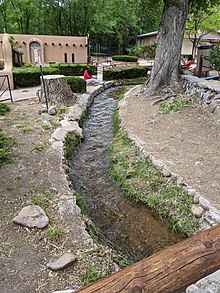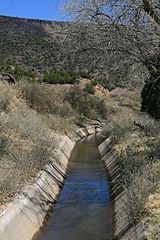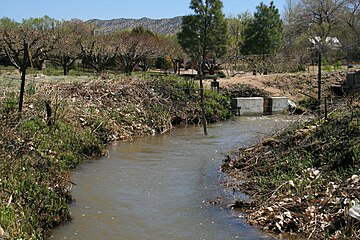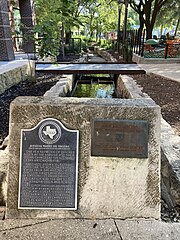
An acequia (Spanish: [aˈθekja]) or séquia (Catalan: [ˈsekiə, -a], also known as síquia [ˈsikiə, -a]) is a community-operated watercourse used in Spain and former Spanish colonies in the Americas for irrigation. Acequias are found in parts of Spain, the Andes, northern Mexico, and the modern-day American Southwest (northern New Mexico and southern Colorado).
Scholars describe acequias as "technological systems that are designed, maintained, and operated to meet a variety of productive goals, social services, and health needs, with the practice of irrigated agriculture being of paramount importance." In the United States, the oldest acequias were established more than 400 years ago by Spanish colonizers. The traditional form of governance over acequias is the oldest form of European resource management still alive in the United States today.
Acequias are filled by snow melt and rain to water orchards, gardens, and other agricultural fields. Other than watering crops, acequias have deep cultural significance for many Indigenous and Native communities in New Mexico and Colorado.
Etymology

The Spanish word acequia (and the Catalan word séquia) originate from Arabic word al-sāqiyah (الساقیة) which has more than one meaning: "the water conduit" or "one that bears water" as well as 'bartender' (from سَقَى saqā, "to give water, drink"), and also refers to a type of water wheel.
History
Traditionally, the Spanish acequias have been associated with the Muslim colonization of the Iberian Peninsula; however the most likely hypothesis is that they improved on irrigation systems that already existed since Roman times, or even before. These ways of agricultural planning and colonization strategies come from the vast amount of cultural influences contributing to Spanish technology and governance. Likely the most meaningful stemmed from the Muslims that ruled parts of Spain for as long as eight centuries. Their ways of life influenced the Spanish and changed the way agriculture was done in Spain.
Acequias were later adopted by the Spanish and Portuguese (levadas on Madeira Island) and were utilized throughout their own colonies. Similar structures already existed in places such as Mendoza and San Juan, Argentina where acequias today run along both sides of the city streets. However, these acequias were originally dug by the Indigenous Huarpes long before the arrival of the Spanish. The introduction of acequias by the Muslims allowed for more agricultural diversity, with crops such as sugar cane and citrus fruits introduced. The system of the acequia has changed over time to avoid incidents of the resource from being overused or under-maintained.

Usage in the American Southwest
In the United States, the oldest acequias were established more than 400 years ago by Spanish colonizers. Many acequias continue to provide a primary source of water for farming and ranching in the region of south central Colorado known as the Upper Rio Grande watershed or Rio Arriba and some 700 in northern New Mexico continue to function. This type of governance over acequias is to date the oldest depiction of European resource management still active in the United States today.
Design
Acequias are gravity chutes, similar in concept to flumes. Some acequias are conveyed through pipes or aqueducts, of modern fabrication or decades or centuries old (see transvasement). For the system to function properly the channel must have a good gradient to maintain the flow of water.
When rainfall and snowmelt start to flow it is carried into the Acequia Madre and through the connecting channels throughout parts of New Mexico. Acequias have several components that control the transport of water:
- compuertas (headgates)- these gates open and close to allow water to flow through the channel
- canoas (canoes)- log flumes that transport water across intersecting creeks and streams
- sangrías (vessels)- lateral ditches cut perpendicular from the main canal to irrigate individual parcels of land
- desagüe (draining channel)- carries surplus water back to the stream source
Researchers affiliated with the Rio Grande Bioregions Project at Colorado College initiated a pioneering collaborative, farmer-led, and interdisciplinary study of Colorado and New Mexico acequias in 1995–99. Among the most significant findings of this study was that the acequia farms provide vital ecosystem and economic base services to the regions in which they are located. One study, as reported in Peña, Boyce & Shelley (2003), found that acequia agroecosystems promote soil conservation and soil formation, provide terrestrial wildlife habitat and movement corridors. They also protect water quality and fish habitat, promote the conservation of domesticated biodiversity of land race heirloom crops, and encourage the maintenance of a strong land and water ethic and sense of place, among other ecological and economic base values. This pioneering research on acequia ecosystem services, led by environmental anthropologist Devon G. Peña, has more recently been confirmed in other studies, e.g. Fernald, Baker & Guldan (2007), Fernald et al. (2010), Fernald et al. (2015), Raheem et al. (2015).
Governance in New Mexico

Known among water users simply as "the Acequia", various legal entities embody the community associations, or acequia associations, that govern members' water usage, depending on local precedents and traditions. An acequia organization often must include commissioners and a majordomo who administers usage of water from a ditch, regulating which holders of water rights can release water to their fields on which days. In New Mexico, by state statute, acequias as registered bodies must have three commissioners and a mayordomo. Irrigation and conservation districts typically have their own version of mayordomos, usually referred to as "ditch riders" by members of the districts.
Acequias in New Mexico and Colorado have successfully developed and implemented changes in state water laws to accommodate the unique norms, customs, and practices of the acequia systems. But the communal owners of the acequias in New Mexico are receiving hard economic pushes from land developers and current inflation that are pushing them to consider selling the valued acequia. The customary law of the acequia is older than and at variance with the Doctrine of Prior Appropriation, and the statutes promulgating acequia water law represent a rare instance of water pluralism in the context of Western water law in the United States (see Hicks & Peña (2003)). For example, the Doctrine of Prior Appropriation is based on the principle of "first in use, first in right", while acequia norms incorporate not just priority but principles of equity and fairness. This is evident in the fact that Prior Appropriation considers water to be a commodity owned by private individuals while acequia systems treat water as a community resource that irrigators have a shared right to use, manage, and protect. The concept of a shared responsibility natural resources reflects the beliefs stemming from the Spanish and Indigenous people who brought the acequia to the U.S. The plethora of cultural behaviors and values that created acequia communities still exist in the United States.
While prior doctrines allow for water to be sold away from the basin of origin, the acequia system prohibits the transference of water from the watershed in which it is situated and thus considers water as an "asset-in-place". The Prior regime is based on a governance regime in which the members of a mutual ditch company will vote based on their proportional ownership of shares so that larger farmers have more votes. In contrast, the acequia system follows a "one farmer, one vote" system that has led researchers to consider this a form of "water democracy".
Acequia law also requires that all persons with irrigation rights participate in the annual maintenance of the community ditch including the annual spring time ditch cleanup known as the limpieza y saca de acequia.
Gallery
-
 Concrete-lined portion of La Canova acequia, near Velarde, New Mexico
Concrete-lined portion of La Canova acequia, near Velarde, New Mexico
-
 Unlined portion of Los Chicos acequia, near Velarde, New Mexico
Unlined portion of Los Chicos acequia, near Velarde, New Mexico
-
 Near the intersection of the Los Padillas Drain and Putnam Drain in South Valley, New Mexico
Near the intersection of the Los Padillas Drain and Putnam Drain in South Valley, New Mexico
-
A section of a compuerta (holding area) and historic acequia in Tumacacori National Historical Park, Santa Cruz County, Arizona The trail beyond the compuerta is the original route of the acequia.
-
 Acequia Madre de Valero historical marker
Acequia Madre de Valero historical marker
See also
- Ditch – Small to moderate trench created to channel water
- Huerta – Irrigated area, or a field within an irrigated area
- Leat – Artificial watercourse or aqueduct dug into the ground
- Levada – Irrigation canal
- Mueang § Müang Fai irrigation system
- Qanat – Middle Eastern water supply system
- Zanja – Historical irrigation system used in the American Southwest
References
Citations
- Rosenberg et al. (2020).
- ^ Romero (2021)
- Gómez (n.d.).
- ^ Burgen (2022)
- ^ Wise & Crooks (2012)
- ^ Rivera (1998), p. .
- Romero (2021b).
- Garcia (2022).
- Gilbert, Samuel (22 April 2024). "Nine practices from Native American culture that could help the environment". Washington Post. Retrieved 24 April 2024.
- Rivera (1998), p. .
- ^ Peña, Boyce & Shelley (2003)
- Rivera (1998), pp. 59–60.
- Office of the State Engineer Interstate Stream Commission (n.d.).
Works cited
- Burgen, Stephen (11 April 2022). "Spring time: why an ancient water system is being brought back to life in Spain; A project to restore a 1,000-year-old network of water channels is helping farmers in the Sierra Nevada adapt to the effects of the climate crisis". The Guardian. Retrieved 15 February 2023.
- Fernald, A. G.; Baker, T. T.; et al. (2007). "Hydrological, Riparian, and Agroecosystem Functions of Traditional Acequia Irrigation Systems". Journal of Sustainable Agriculture. 30 (2): 147–71. Bibcode:2007JSusA..30b.147F. doi:10.1300/J064v30n02_13. S2CID 84955013.
- Fernald, A. G.; Cevik, S. Y.; et al. (2010). "River hydrograph retransmission functions of irrigated valley surface water–groundwater interactions". Journal of Irrigation and Drainage Engineering. 136 (12): 823–835. doi:10.1061/(ASCE)IR.1943-4774.0000265.
- Fernald, A.; Guldan, S.; et al. (2015). "Linked hydrologic and social systems that support resilience of traditional irrigation communities". Hydrology and Earth System Sciences. 19 (1): 293–307. Bibcode:2015HESS...19..293F. doi:10.5194/hess-19-293-2015.
- Garcia, Paula (February 2022). "Acequias Brace for a Future of Water Scarcity". Green Fire Times.
- Gómez, A. López (n.d.). "Los canales romanos" (PDF) (in Spanish). Retrieved 10 August 2023.
- Hicks, Gregory A.; Peña, Devon G. (2003). "Community Acequias in Colorado's Rio Culebra Watershed: A Customary Commons in the Domain of Prior Appropriation". University of Colorado Law Review. 74: 387–486.
- Office of the State Engineer Interstate Stream Commission (n.d.). "Acequia Information". ose.state.nm.us. State of New Mexico. Retrieved 23 June 2022.
- Peña, Devon G.; Boyce, James K.; Shelley, Barry G. (2003). "The Watershed Commonwealth of the Upper Rio Grande". Natural Assets: Democratizing Environmental Ownership. Washington, D.C.: Island Press. pp. 169–85. ISBN 1-55963-539-8.
- Raheem, N.; Archambault, S.; Arellano, E.; Gonzales, M.; Kopp, D.; Rivera, J.; Guldan, S.; Boykin, K.; Oldham, C.; Valdez, A.; Colt, S.; Lamadrid, E.; Wang, J.; Price, J.; Goldstein, J.; Arnold, P.; Martin, S.; Dingwell, E. (2015). "A framework for assessing ecosystem services in acequia irrigation communities of the Upper Río Grande watershed". WIREs Water. 2 (5): 559–575. Bibcode:2015WIRWa...2..559R. doi:10.1002/wat2.1091. S2CID 129710529.
- Rivera, Jose A. (1998). Acequia Culture: Water, Land, and Community in the Southwest. Albuquerque: University of New Mexico Press. ISBN 0-8263-1858-4.
- Romero, Eric (2021). "Southwestern Acequia Systems and Communities; Nurturing a Culture of Place". Natural Resource Journal. 61 (2): 169–172.
- Romero, Simon (13 July 2021b). "Drought Hits the Southwest, and New Mexico's Canals Run Dry". The New York Times. Retrieved 14 July 2021.
- Rosenberg, Adrienne; Guldan, Steven; Fernald, Alexander G.; Rivera, José, eds. (November 2020). "Acequias of the Southwestern United States: Elements of Resilience in a Coupled Natural and Human System". College of Agricultural, Consumer and Environmental Sciences, New Mexico State University.
- Wise, Sarah; Crooks, Andrew T. (1 November 2012). "Agent-based modeling for community resource management: Acequia-based agriculture". Computers, Environment and Urban Systems. Special Issue: Advances in Geocomputation. 36 (6): 562–572. doi:10.1016/j.compenvurbsys.2012.08.004. ISSN 0198-9715.
Further reading
- Glick, Thomas F. The Old World Background of the Irrigation System of San Antonio, Texas. El Paso, Texas: Western Press, 1972. Spanish version, in Los cuadernos de Cauce 2000, No.15 (Madrid, 1988); also in Instituto de la Ingeniería de España, Obras hidráulicas prehispánicas y coloniales en América, I (Madrid, 1992), pp. 225–264.
External links
- The Acequia Institute
- The New Mexico Acequia Association
- The New Mexico Acequia Commission
- Sangre de Cristo Acequia Association
- Taos Valley Acequia Association